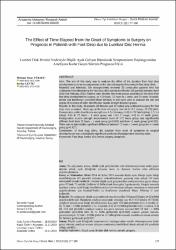| dc.contributor.author | Yüksel, Mehmet Onur | |
| dc.contributor.author | Çevik, Serdar | |
| dc.date.accessioned | 2022-05-11T14:34:48Z | |
| dc.date.available | 2022-05-11T14:34:48Z | |
| dc.date.issued | 2019 | |
| dc.identifier.issn | 1307-671X | |
| dc.identifier.uri | https://doi.org/10.18678/dtfd.606028 | |
| dc.identifier.uri | https://hdl.handle.net/20.500.11776/8097 | |
| dc.description.abstract | Aim: The aim of this study was to evaluate the effect of the duration from foot drop development to nerve decompression on the rate and degree of recovery in foot drop clinic. Material and Methods: We retrospectively reviewed 30 consecutive patients who had undergone microdiscectomy for foot drop clinic (ankle dorsiflexion 0/5 paresis) between April 2014 and February 2019. Patients were divided into three groups according to the time from foot drop development to surgery, as <72 hours, 72 hours to 1 week, and >1 week. Kruskal-Wallis and Bonferroni corrected Mann Whitney U test were used to evaluate the rate and degree of recovery of ankle dorsiflexion muscle strength between groups. Results: In this study, 30 patients (18 females and 12 males) who underwent surgery for foot drop were evaluated. Mean age at the time of surgery was 46.5±13.5 (range, 18-72) years. Postoperative ankle dorsiflexion strength was 4.2±1.6 (range, 0-5) in <72 hours group, 1.7±1.6 (range, 0-5) in 72 hours-1 week group and 1.0±1.3 (range, 0-3) in >1 week group. Postoperative muscle strength improvement level of <72 hours group was significantly different both from 72 hours-1 week group (p=0.003) and from >1 week group (p=0.002). There was no statistically significant difference between 72 hours-1 week group and >1 week group (p=0.427). Conclusion: In foot drop clinic, the duration from onset of symptoms to surgical decompression was a statistically significant predictor of postoperative recovery rates. © 2019, Duzce University Medical School. All rights reserved. | en_US |
| dc.description.sponsorship | Medical Research Council, MRC: Table1 | en_US |
| dc.description.sponsorship | A total of consecutive thirty patients, who had undergone microdiscectomy due to foot drop clinic (ADF 0/5 paresis) by the same surgical team in two different state hospitals between April 2014 and February 2019, were retrospectively reviewed. Clinical records, radiological imaging reports and surgical reports were reviewed. Data on patient demographics and clinical features, the time elapsed between the development of foot drop and surgery, duration of surgery, and muscle strength of ADF in the early post-operative period were reached. The evaluation of muscle strength of the ADF was carried out by the assessment of the tibialis anterior muscle in accordance with the muscle strength scale of Medical Research Council (Table1). Comorbidities, including diabetes mellitus (DM), smokers, coronary artery disease, chronic obstructive pulmonary disease (COPD) and hypertension were ascertained from the medical records. All procedures carried out in studies including human participants were conducted in compliance with the ethical standards of institutional and/or national research committee, the Helsinki Declaration and its amendments or comparable ethical standards. Ethical approval for the study was obtained from the institutional review board of Namık Kemal University (01.08.2019, 2019/21). Informed and written consent was obtained from all patients. The patients were divided into three groups as regards the time elapsed from the development of foot drop to surgery, as <72 hours, 72 hours to 1 week, and >1 week. Statistical Analysis Normality assumption for continuous data were examined by Shapiro-Wilk test. The differences between the groups were analyzed by Kruskal-Wallis test followed by Mann Whitney U test with Bonferroni correction, since variables not showing normal distribution. Descriptive statistics given as mean±standard deviation and median (minimum-maximum). Categorical data were analyzed with Fisher-Freeman-Halton test and summarized as frequency and percentage. All statistical analyses were performed using MedCalc v.12.7.7 (MedCalc Software, Ostend, Belgium), and p<0.05 was considered statistically significant. | en_US |
| dc.language.iso | eng | en_US |
| dc.publisher | Duzce University Medical School | en_US |
| dc.identifier.doi | 10.18678/dtfd.606028 | |
| dc.rights | info:eu-repo/semantics/openAccess | en_US |
| dc.subject | Foot drop | en_US |
| dc.subject | Lumbar disc hernia | en_US |
| dc.subject | Prognosis | en_US |
| dc.subject | Surgery | en_US |
| dc.title | The effect of time elapsed from the onset of symptoms to surgery on prognosis in patients with foot drop due to lumbar disc Hernia | en_US |
| dc.title.alternative | Lomber disk hernisi nedeniyle düşük ayak gelişen hastalarda semptomların başlangıcından ameliyata kadar geçen sürenin prognoza etkisi] | en_US |
| dc.type | article | en_US |
| dc.relation.ispartof | Duzce Medical Journal | en_US |
| dc.department | Fakülteler, Tıp Fakültesi, Cerrahi Tıp Bilimleri Bölümü, Beyin ve Sinir Cerrahisi Ana Bilim Dalı | en_US |
| dc.identifier.volume | 21 | en_US |
| dc.identifier.issue | 3 | en_US |
| dc.identifier.startpage | 177 | en_US |
| dc.identifier.endpage | 180 | en_US |
| dc.institutionauthor | Yüksel, Mehmet Onur | |
| dc.relation.publicationcategory | Makale - Uluslararası Hakemli Dergi - Kurum Öğretim Elemanı | en_US |
| dc.authorscopusid | 55843167500 | |
| dc.authorscopusid | 56516611400 | |
| dc.identifier.scopus | 2-s2.0-85077587729 | en_US |



















